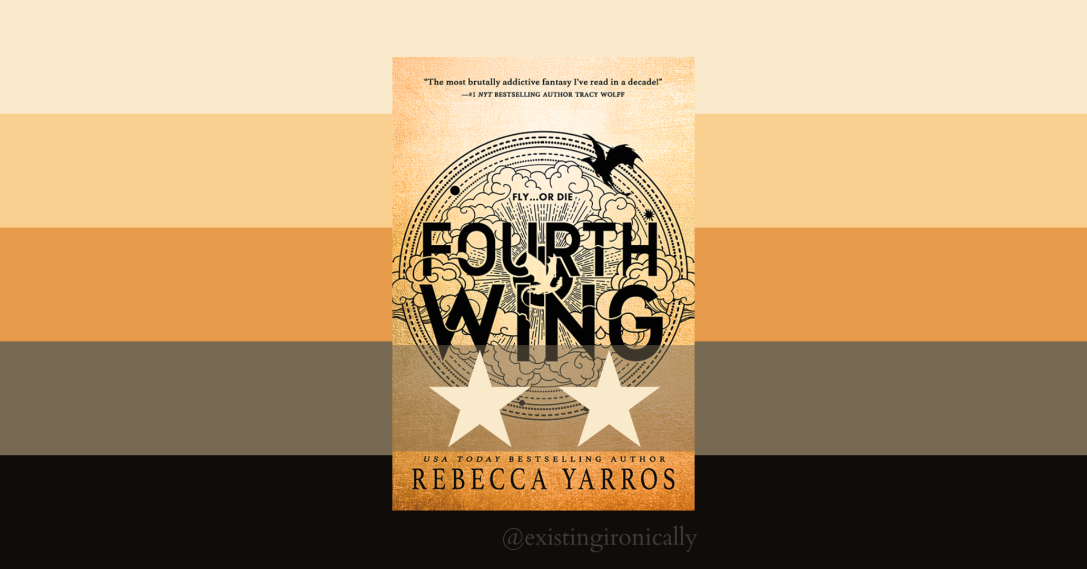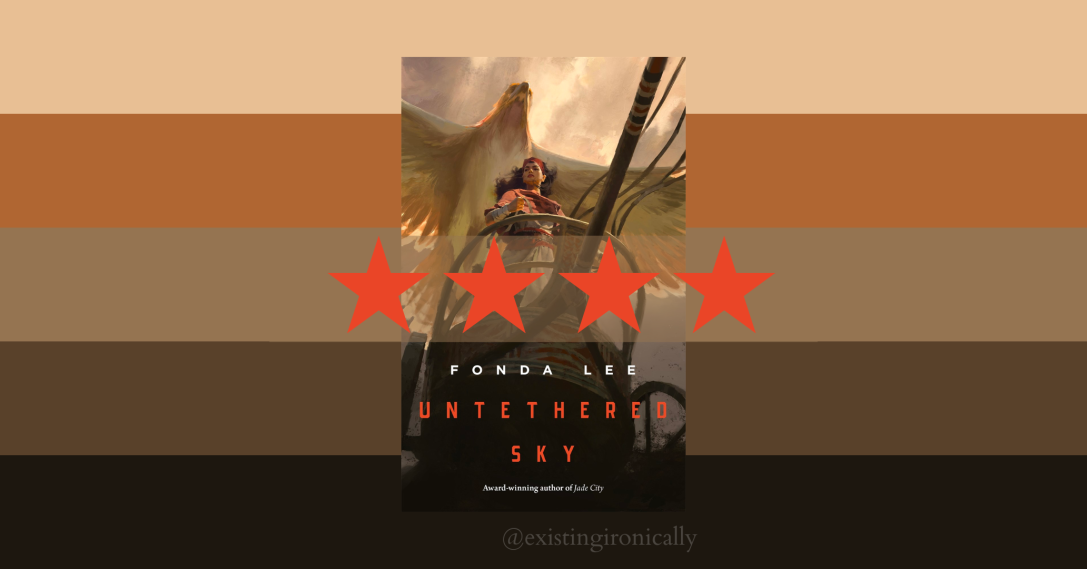Fourth Wing by Rebecca Yarros is backed by the Tiktok Hype Industrial Complex and I’ve got FOMO.
I am going to make one thing quite clear. This is not an unbiased review. I did not go into this book with an open mind. I typically don’t like this vein of fantasy romance, but normally it’s something I’m willing to push aside until the book begins to speak for itself. I had no such intentions for this book, because I made the terrible mistake of reading the author bio before I read the first word of her novel.
“A second-generation army brat, Rebecca loves military heroes and has been blissfully married to hers for more than twenty years.”
A dark cloud descends over my mind. Lightning strikes in the distance. Thunder rumbles underhead.
I am not going to pretend to understand the current politics of being a military wife. I don’t know where they stand on, like, the current war and sending our #troops overseas to drone strike Yemeni villages or whatever. But my guess is that they really don’t care, because if they did, their association with the military would not a badge of honor trampstamped across the backside of their novel. I cannot pretend to know exactly how Rebecca Yarros feels about the current state of US imperialism, the US industrial complex, or US foreign relations, but I can point to that line in her bio and say it makes me deeply uncomfortable. Because, like, what exactly about “military heroes” do you love so much?
A military hero cannot exist without a military villain. They are on opposite sides of the propaganda machine, one cannot exist without the other, and for every military hero you prop up, there’s another person, or rather sort of person, you kick into the dirt. Did you love the movie ‘American Sniper’, Rebecca Yarros? Is that the kind of military hero you love? Because after it came out, there was a rise in anti-Muslim threats.
Yeah, so basically, military brat writes war novel. But even if the book is more anti-war than a Nixon era hippie protest on the steps of the US capitol, I still don’t think military hero worship is cute, or ever will be. I don’t think supporting the US military is cute, or ever will be. I think we should normalize shaming people who support the military. (Veterans are a different conversation, and one that I am not very interested in having right now.)
So. Is the book anti-war? Well. It’s as much pro war as it’s anti war because it’s a whole lot of nothing.
In Fourth Wing, Violet is conscripted into war college to become a dragon rider. It’s dangerous. A lot of people die doing it. Her mom is a hot shot general who basically killed the parents of a bunch of rebel’s kids who are mandatorily conscripted, so a lot of people at the school want her dead. And at this school, you can just do that. You can just kill people. There are some rules sprinkled in here and there, but we basically see a kid get murked during sparring practice and the murderer just shrugs like “oopsies”.
The entire rules surrounding the school and who’s allowed to kill who when and why so many parents are okay with their kids dying and why the war would be okay with their conscripts dying require a lot of suspension of disbelief. And the logic of who wants to kill Violet when also requires suspension of disbelief. At one point someone remarks that after graduating from War University, people will protect Violet to stay in her mother’s good graces. Why doesn’t that protection extend into the school? Surely, if someone kills her daughter, she’d hate them after graduating. Because Yarros needed the plot, and the plot of this book is, “Violet doesn’t want to die.”
It took me about 60% into the novel before I realized nothing was really happening. This book bamboozles you pretty bad. The first chapter is really long and a ton of it is just blatant over the top exposition. Like, the main character literally recites a textbook to the audience. And then the exposition just keeps going. It doesn’t feel like you’re learning about the world in a natural way to progress the story. It feels like you’re being fed exposition through scenes of Violet lusting over another man and trying not to die. And while “trying not to die” sometimes works as a plot, it just didn’t here.
The focus of this book, besides the endless exposition, was clearly the romance. Xaden. Enemies to lovers. Except not really. Yarros never defines them as ideological enemies, only as circumstantial enemies, which aren’t really enemies. Your mom killed my dad. Okay. Same sort of thing happened in West Side Story, but they were on the same page about it. (JOKE).
Oh, but he wants to kill her. Or rather, she thinks he wants to kill her, but he really doesn’t, and the audience knows that, and he tells her that and she just doesn’t believe it. For the first 30% of the book, they don’t even know each other and he most definitely is not trying to kill her. For the next 70%, they are on the same side. They are instantly horny for each other. I guess it could be fun to read in a trashy when-will-they sort of way, but it does not deliver the enemies to lovers intensity you’d expect. I found it dull.
Oh, not to mention that there’s supposed to be a love triangle in this. It’s not really a love triangle, because Yarros was not interested in making the second love interest a desirable option. He’s the classic childhood best friend, and his name is Dain. He’s a squad leader, so logically, within the narrative, he must have some sort of skill or capacity for usefulness in his day-to-day operations. We see none of it. He’s nice to Violet, but overbearing, and not sexy enough. It seems that he has no desire but to abide by the rules and protect Violet. He’s barely a character. It’s trite.
I have mixed feelings on Violet. On one hand, I am a small girlie described as frail and undervalued because of this. I understand that Violet had a chronic illness, so I’m not gonna pretend to relate on that front or comment on that sort of representation, other than the fact that it was incorporated into the novel in a natural way. I appreciated how, in that sense, she didn’t feel like the typical fantasy heroine. Her flaws were well defined and how she overcame them was realistic enough. She’s easy to project onto. Comma. But.
Xaden’s nickname for Violet is Violence. (I found this 2 be CRINGE!) She has this whole arc about coming into her power or whatever, but a biproduct is that she is very dangerous. She can really hurt people. She’s a weapon. This makes her upset, but Xaden is like don’t be ashamed of being a weapon, be proud to be the weapon. Which like. Nice on paper, in an insular sense of “own your strengths”. Bad when you take a couple of steps away from the paper. Terrible when you remember the author is an army wife.
Interlude: I Discuss the Technicalities.
Prose: This is a voicey fantasy. It’s riddled with modern slang and anachronisms, with the narration resembling that of a contemporary romance rather than a fantasy. I don’t particularly like this! It might be your cup of tea! But it isn’t mine! Mostly because it was common on Wattpad when I was 13 and I don’t like reliving those days. I did my time. I have grazed those fields and am now going on to different pastures.
Editing: There were some weird sentences in here. I have a couple of highlights like “‘You know very well the natural pigment seems to gradually abandon it no matter the length.'” One, that’s not good dialogue. Two, badly constructed sentence. Just say gradates. PLEASE. These sorts of mistakes weren’t super common, but when they were present, they did pull me out of the book.
Pacing: This book gave me a little bit of my old Wattpad buzz, but I’m not sure it was its intrinsic quality as a page turner or if it was because I dared myself to finish it in one day (I didn’t). Either way, I do think it’s bloated. Because this book stakes its central conflict on Violet’s survival, once she ends up in a relatively safe position, it loses momentum. There are clear separate acts in the book, but as one ended, it became increasingly difficult to become invested in the next. If her life will always be in danger, what’s the motivation to keep reading? When will it end? Once I hit the 60% mark, boy howdy, I was ready to throw in the towel. Yes, that’s when the romance ramps up, but too bad the romance is uninspired. Like, relies on 20 questions to be endearing type of uninspired.
Dragons: Personalities but no insights. Their backstories were the stuff of legends, not points of connection. I had no idea what their motivations were. They didn’t feel like characters in their own right, merely support for their riders. Yarros tried to dissuade this idea by showing them to be adversarial or blabber something about how they do what they want by their own rules, but it doesn’t really land. The last series I had to read with magic interlinking sex and also dragons was the Farseer trilogy and I think that it was very brave of Rebecca Yarros to stitch together those ideas, but if she was gonna do that, then she should’ve written a book as good as any in that trilogy.
Vibes: People describe this as fun because there’s sarcasm and banter in it. I wouldn’t call it fun, but if that’s what your idea of fun is, go live your life. I’m not your mom. But if you agree with me, then know that this book is not fun.
Interlude: Fin.
I’m going to do my best to sum up my issues with the war sentiments in this book without spoiling anything or going into too much detail. If you want to go in completely blind, tap out now. If you’d be alright with some mild spoilers, proceed with your own caution.
For 80% of the book, you have no clue why these two nations are at war. There’s a throwaway line about how the enemy isn’t content with their resources and is greedy, but we all know that’s not really a reason wars are fought. Yet, that’s all we get. People are dying left and right, we hear about how taxing this war is, but the only ideology behind it is greed, so it doesn’t really feel real.
When we learn about the rebellion, it’s only about the effects of the rebellion. Because of the rebellion, the marked conscripts are orphaned, they hate Violet, they’re ostracized, etc etc. We don’t really know what the rebellion entailed. We don’t know in what way their parents betrayed the kingdom, or if they agreed with that decision. There are no politics, only the effects of said politics, which is why so much of the book seems hollow.
All of this hollowness culminates in some great reveal about the true reason for the war. Call me stupid, but when the book was done I had to go back and name search the countries to try and piece together why it was such a shocking reveal. We were given so little substantial information, the characters believed in so little to begin with, that it couldn’t have been a subversion. There was nothing to subvert. It turns out those dry textbook clippings were supposed to mean something for the story, but it was really hard to keep my eyes from glazing right over them because I had no reason to care about it because the characters didn’t care about it.
Up until the very end, I’d say the last 10%, I would say that this book was borrowing the aesthetics of war as a vehicle for some story about survival. I already hate that. By the end, when we learn the truth, it’s strange. Yarros is attempting to say nothing without having anything of substance to say. The great wool over the main character’s eyes in this book doesn’t say anything about the morality of war or how propaganda operates. If the book was about morality, the main character would have believed in the morality of a cause worth fighting and dying for (she doesn’t). If the book was about propaganda, we would have seen how the government brainwashed her (they don’t push a narrative, only hide things).
I see people bring up the military-industrial complex when it comes to this book, and I must respectfully disagree. I think that people just like… don’t know what that term means. It’s specific. It refers to the way that the private weapons manufacturers, the government, and the military interact with each other to perpetuate war because it is profitable for all of them. If war, then government get to have weapon and Lockheed Martin get to sell weapon. It’s not about how war is profitable because of its spoils or how people perpetuate war out of greed. The military-industrial complex isn’t about how the oil corporations pushed the US into invading Iraq, it’s about how weapons manufacturers push the US into supporting Israel so that they can get paid for the missiles they supply to them. This isn’t a huge deal, just a distinction that I find important, because I talk about imperialistic themes in media a lot and I like being precise.
In Fourth Wing, weapons are brought up in how they relate to the war, but it has nothing to do with the profitability of manufacturing them. Instead, the reason for the war becomes somewhat of a trolly problem. An us or them sort of thing. It can only exist as a hypothetical, and so still, it says nothing.
One thing the book is weirdly consistent with is the necessity of violence. Violet must become a weapon to survive. Violence against a foreign enemy is required in order to have peace. Either we must fight a warring nation to secure ourselves, we must fight with them to secure the both of us, but either way, we must fight.
This, believe it or not, is actually a form of US military propaganda. (I know you are soooo sick of me by now).
The United States Military justifies its far reach into other countries by parading as the global police force of the world. They believe that safety and security can only be achieved under the threat of violence. They perpetuate war by perpetuating the idea that the world needs violence to be secure.
This is part of the reason I found the “Violence” nickname, and the context surrounding it, to be troublesome. It’s why I found the cavalier nature of the slew of deaths to be worrying. It’s robbing war of context, yet still insisting that it is necessary. Death is necessary, but it isn’t something you should worry about unless it’s coming for you. In that case, it is kill or be killed. This is the nature of things.
Except it isn’t. And the book’s insistence that it is frustrated me. I don’t care if she corrects this in a sequel, it’s bad storytelling. Not only is it careless, it is lazy. If people are dying on page, there should be a good reason, or at least the attempt of a real good reason, other than to create stakes. A character becoming a weapon out of necessity is boring. You may disagree with me. That’s fine. But it’s boring. I am so bored.
So yeah, Fourth Wing. Not it. (I know I talk about a lot of things in this review, but by far, its biggest sin is the terrible exposition. So yeah.)
(I wish this was a silly review poking fun of the fact that you needed magic to use a pen or other weird convoluted aspects of the worldbuilding, but depictions of the military and war in media are much too important for me to disregard. Sorry I’m like this. I’ll find something silly soon.)
For more writing on imperialism and military propaganda in media: see my Black Adam review.





